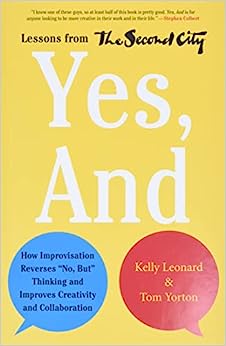Table of Contents
Introduction
Yes! Some of the best actors in the business, like Tina Fey, Mike Myers, Steve Carell, Stephen Colbert, and Gilda Radner, went to The Second City, which is widely thought to be the best school for comedy theater and improv in the world.
Now, leaders from the organization demonstrate how the concepts they learned through improv can be applied to the world of business.
You have to understand that The Second City isn’t just known for producing some of the most talented improv actors in the business; in addition to that, they also offer leadership training for progressive businesses, charitable groups, and government agencies.
Their training places a strong emphasis on teamwork, collaboration, and creative problem solving.
What was successful for companies a few decades ago is not successful for them anymore.
Instead, successful businesses do away with the conventional company hierarchies and implement tactics that encourage creative problem solving and business growth.
Yes, And helps firms build the required skills to enhance productivity and creativity from employees. Additionally, Yes, And can teach any business or organization how to develop the leadership skills needed for success in today’s world.
These abilities are based on the eight principles of improvisation.

Chapter 1
THE POWER OF YES AND ITS CONSEQUENCES
Do you ever find yourself pondering what the secret to success may possibly be? The authors Kelly Leonard and Tom Yorton believe that the improvisational method of saying “Yes, And” is applicable in both the corporate world and the world of acting.
You have to be able to make something out of nothing in order to achieve success because the list of things that successful business professionals have to make out of nothing on a daily basis is limitless.
For instance, firms develop marketing campaigns, new goods and jobs, employee training programs, reactions to customer complaints, and many other things.
Therefore, how exactly does the improvisational method of “Yes, And” lead to successful outcomes?
To begin, you will need to have a solid understanding of the Yes, And strategy. When actors are improvising on stage, they do not have a script to follow.
Instead, it is up to them to decide where the drama will go.Actors employ the yes, and technique to do this.
For instance, one actor may offer an idea while they are performing on stage and say something along the lines of, “Wow, I’ve never seen so many stars in the sky.”
If the second actor chooses to ignore the Yes, And strategy, he may respond by saying, “I can’t see a single star…it’s broad daylight.”
In this scenario, the scene comes to a grinding halt, and the first actor is forced to think of a way to make the scene more interesting. Instead, the second actor should agree with the first and offer something new to the scene.
As a result, the second actor should answer with something along the lines of “I know. Things appear to be rather different from this vantage point on the moon.
This straightforward sentence makes use of the conjunctions “Yes, And” to confirm what the previous actor stated and even opens up a great deal more potential outcomes for the scene.
Actors use this technique to establish rich, comedic characters, which, in turn, allows them to create scenes and, ultimately, complete shows.
In a similar vein, having an attitude of “Yes, and” might assist in opening numerous doors to opportunities in business.
For instance, the insurance provider Farmers Insurance thinks that employing this method enables leaders to maintain an attitude that is receptive to novel suggestions from their workforce.
One of the participants said, “Yes, and showed me that you’re not going to love every idea, but it helps to love it for at least a little while,” which exemplifies the point that this activity demonstrated.
In fact, the early reception of many franchises and goods was not always favorable. For instance, it was difficult to sell the idea of “a show about nothing” for the sitcom Seinfeld, which was conceived by Larry David and Jerry Seinfeld. J.K. Rowling.
Rowling, the author of the Harry Potter series, had her work rejected by a number of publishers who couldn’t understand how the story of a boy who could cast spells could captivate audiences.
Even Tony Fadell, the man who invented the iPod, had his proposals turned down by a number of corporations before Steve Jobs said yes. At the end of the day, it is essential to give even the most outlandish concepts a second, third, or even fourth look.
Effective leaders must be able to think “yes, and.”Not only does it allow for the development of new concepts and ideas, but it also gives each person the impression that they have been heard and is valued. And when there is mutual respect between companies, wonderful things can take place.
Chapter 2
BUILD AN ENSEMBLE
When we talk about anything related to business, we frequently use the phrase “team.” We are constantly reminded of the significance of developing strong teams, and organizations actively work to improve the performance of team members as individuals.
The disadvantages of employing the term “team,” however, are brought to light in The Second City. They refer to themselves instead as an ensemble, we frequently use the phrase “team.”
We are constantly reminded of the significance of developing strong teams, and organizations actively work to improve the performance of team members as individuals. The disadvantages of employing the term “team,” however, are brought to light in The Second City.
They refer to themselves instead as an ensemble. You have to understand that the word “team” generally connotes competition, typically with another team.
On the other hand, the term “ensemble” suggests that all of the individuals are cooperating as though they were a single entity.
The idea of a team itself implies that there is some kind of ranking system. Consider, for instance, a boys’ or girls’ varsity basketball squad from a high school.
The fact that you have starting players and bench players sends the unmistakable message that certain members of the team are simply not as vital as others.
The members of an ensemble, on the other hand, are not required to adhere to any sort of hierarchy and are free to contribute whenever they see fit.
The question now is, how do you get started developing a powerful ensemble? To begin, you are going to require some variety.
Suppose there was a baseball team that solely recruited right-handed sluggers; do you think they would have much success? Almost certainly not.
A similar philosophy is utilized by The Second City, which maintains that the search for a diverse group of individuals is the first step in the creation of a successful ensemble.
Each person should bring to the group both strengths and deficiencies that will be mitigated as a result of their participation in the group as a whole.
The same tactic, referred to as “hiring different,” can be utilized by businesses.
Consider the ensemble that worked at The Second City in the 1970s and 1980s, when the ensemble started developing a pattern that was easy to anticipate.
They had the innocent party, the straight man, and the humorous obese guy all in one group. In addition, for the first three decades of The Second City’s run, the show’s cast was virtually entirely comprised of straight white men.
In the end, the company came to the conclusion that its touring companies should be gender balanced.
Because of that decision, several talented actors, like Tina Fey, Rachel Dratch, and Jenna Jolovitz, went on to become well-known performers and writers for TV shows like Mad Men and Saturday Night Live.
Because of the years in which the number of women and men performing on their stages was comparable, The Second City Training Center currently has a greater percentage of female students than male students.
Despite this, there was still one issue remaining. The cast consisted entirely of white people, which was a problem that surfaced during the race riots in Los Angeles.
At that time, the performers decided to put on a show that brought humor to the tragic events that were taking place on the West Coast.
However, this highlighted the fact that the casts were all white. In order to increase the amount of diversity in the firm’s workforce during that summer, the company developed initiatives for outstanding people of color.
Diversifying your group is important if you want to be open to a wider range of new ideas and opportunities.
Diversity is the key to coming up with new ideas and building the most powerful group you can imagine.

Chapter 3
THE VALUE OF CO-CREATION AND COLLABORATION
In 1998, The Second City staged a practice scene that began with a theft at a vault housing “all the gold in Metropolis.” Before the robbers could make their escape, Superman arrived on the scene; however, he entered the scene in a wheelchair rather than soaring in with his iconic red cape.
The audience’s response was one of strong disgust for what had just happened. You see, just a few years before, Christopher Reeves, the actor who is most famous for his depiction of Superman, was involved in a horse-riding accident that left him paralyzed and confined to a wheelchair.
He became paralyzed as a result of the tragedy.
In this particular instance, the responses taught The Second City a valuable lesson about the significance of paying attention to the audience.
It turned out that the scene was only a rehearsal, but the director still wanted to find a way to make the scenario more interesting to the audience so that they wouldn’t feel alienated.
Because of this, the filmmaker decided to have Superman sing to the crowd, which turned the sequence into one of the most talked-about pieces of art from that era. So, what are some important takeaways for businesses from this narrative? The value of working together to create anything.
For co-creating within an ensemble, it’s important to know how to work well with others to figure out what works.
SCTV, a sketch comedy show on TV that is similar to Saturday Night Live and is made by The Second City, is a good example of successful co-creation because the show was made by more than one person.
Beginning in 1976, the show evolved into a fantastic illustration of teamwork, using ideas contributed by a variety of people, including those responsible for the hair, cosmetics, and costumes.
The show quickly became a smash hit, and in 1981, NBC decided to broadcast it on their network.
SCTV would go on to be nominated for fifteen Emmy Awards and launch the careers of actors like John Candy and Eugene Levy.
However, NBC started to take more and more control over the creative process, which made the cast and staff of the show angry.SCTV would go on to be nominated for fifteen Emmy Awards.
1984 was the year that marked the end of the show’s run since the cast and crew were no longer able to work together effectively.
You have to realize that one of the most important aspects of successful collaboration is giving everyone a chance to be heard, but fear is one of the most common barriers that individuals face.
People are afraid of a lot of different things, like failing, looking stupid, or the unknown. On the other hand, fear is harmful to creative endeavors, and no business or organization can ever be successful or innovative if fear is its driving force.
When confronted with fear, some people get aggressive, start shouting, and try to raise their volume over that of everyone else in the room. Unfortunately, this strategy prevents people from working together and stifles their creative juices.
Instead, the key to good collaboration and co-creation between ensembles is to maintain calm and refrain from yelling and aggressive behavior wherever possible.
Chapter 4
COMEDY IN THE WORKPLACE IS THE TOPIC OF
There is always room for fun and comedy at a place of business, no matter how serious the setting may seem. In fact, comedy can be an effective technique for easing tension, particularly when confronted with significant change.
However, simply having a witty personality is not enough. Instead, it is essential to make good use of comedy, and in order to do so, you must first have a solid grasp of the nature of the genre. Exactly what is it, then?
Now, in order to have a successful comedy routine, you need three things: recognition, pain, and distance. A scene that took place during the Monica Lewinsky affair in the late 1990s is a good illustration of how all three of these aspects can be used effectively together.
The scenario starts out silent, with two actors seen interacting with one another in the kitchen without speaking. The audience started laughing as soon as they identified the behavior of a married couple arguing since it was so familiar to them.
In a tone that was unmistakably reminiscent of Bill Clinton’s southern drawl, the male actor pleaded, “Hillary…”
The audience immediately realized that the two performers were, in fact, the two people involved in the political controversy that was dominating every news outlet in America. This revelation came as no surprise to the audience.
Not only could the people in the audience relate to the plot of the Clinton sketch, but many of them could also feel the pain and discomfort that two people feel when one of them cheats on the other.
To put it another way, “You can’t have comedy without something just a little bit uncomfortable.” The divide that existed between the Clinton family and the average audience member was another factor that contributed to the popularity of the sketch.
The sequence was a success despite the fact that very few audience members would have had any personal connections with the Clintons, as the comedy was done at the White House, where it is possible that it would not have generated as many laughs as it did.
So, how exactly can you implement these components into your daily routine at work? Let’s start by addressing the issue of change.
Many people find change challenging, and when firms start to collapse, it almost always indicates that tough changes need to be implemented.
In these kinds of situations, comedy may be an effective tool for having a conversation that is lighthearted while still being frank about the problems that exist.
Take, for instance, the letter that Andrew Mason wrote in which he announced his retirement from Groupon. The first thing he says is, “After four and a half intense and wonderful years as CEO of Groupon, I’ve decided that I’d like to spend more time with my family.
” He goes on to say that he’s looking forward to spending more time with his family. I’m just joking, but I lost my job today. He then went on to outline the problems that Groupon has experienced over the past several years and how, as CEO, he was responsible for those failures.
If you’re asking why, it’s because you haven’t been paying attention. He then said that.
As you can see, Mason used humor to relieve the tension of announcing his departure and gave a light-hearted twist on being fired. He also used humor to put a lighthearted spin on being laid off.
In today’s society, honesty, transparency, and authenticity are critical qualities for businesspeople to possess, and Mason possessed all three.
In addition to this, people continued to appreciate him. Mason may not have been successful in his role as CEO, but he did not try to shift blame to others or conceal his own wrongdoings. Mason, on the other hand, accepted responsibility for his actions, which earned him respect from others.
By using comedic and improvised techniques, you can create an environment that encourages open communication, trust, support, and respect.
Change is inevitable, and you can be sure that you’ll face problems and situations that will be hard to solve. On the other hand, comedy makes these situations easier to deal with and opens up ways to talk and connect.
After those doors have been opened, having those talks will be a great deal less difficult.

Chapter 5
Learn to Embrace Failure
Although many people are afraid of failing, it is essential to keep in mind that failure is inevitable. In fact, some of the most successful organizations have had hundreds of setbacks in various endeavors.
For instance, The Second City discusses some of their most embarrassing moments, such as the introduction of a new dish at a restaurant in Toronto that they formerly managed.
This new menu addition was given the name “Royster Oyster,” and it consisted of a hamburger that had an oyster placed on top of it.
However, before long, a line of ambulances formed outside the restaurant to transport hundreds of customers who were ill with food poisoning to the hospital.
That item in the menu was not successful. The company also came to the conclusion at one point that improvisation did not have to be comedic at all times.
As a result, they hired a storefront close to Wrigley Field so that people might meet there for a night of improv. However, rather than comedic scenes, the actors created dramatic ones.
As it turned out, dramatic improv was both pretentious and boring, and even former members of Second City jumped out of their seats to escape the impending catastrophe.
Of course, there have been even more successes for the organization despite the significant number of failures. They are no longer afraid of failing since they have gained wisdom from their past blunders.
Failing indicates that you’re willing to take risks and do things that other people aren’t willing to try. The first step in developing a workplace that sees improvements in production, morale, and innovation is to accept the fact that failure may and will occur.
Therefore, how can businesses create an atmosphere that celebrates and encourages failure?
First and foremost, it is the responsibility of employers to provide low-hazard learning opportunities for their staff members so that they can expand their horizons.
After you have decreased the stakes, you will have more time to relax and observe what transpires.
Take, for example, the software business Basecamp, which is based in Chicago. They developed a well-liked tool for managing projects that gave their staff the freedom to point out defects in product designs without worrying that they would be punished.
Executives took it a step further and, during a meeting attended by the entire firm, they staged a “product roast” to highlight the deficiencies of items that were still in the process of being developed.
This tactic was beneficial for all involved, since executives were able to gain insight into the shortcomings of their ideas while employees were provided with a secure environment in which to voice their concerns.
In other words, Basecamp designed an environment in which it is acceptable to make mistakes.
In addition to this, it is essential that you have each other’s backs in the event that you are unsuccessful. To put it more succinctly, there needs to be trust and respect among all of the employees in the business.
Respect is taken very seriously in the Second City; in fact, they have a saying that advises them to “always take care of your partner” to serve as a constant reminder of this principle.
Even going so far as to give one another embraces before performing on stage and telling one another, “I got your back,” these verbal and tactile gestures serve as a simple reminder that they are not alone and that they are supported.
At The Second City, they adhere to the philosophy that the only way to learn to achieve together is to first learn to fail together.
Chapter 6
FOLLOW THE ONE WHO’S FOLLOWING YOU
In terms of management, what do you think the standard operating procedure for a business should be? Peter Drucker, who is considered to be a management expert, is of the opinion that hierarchical business structures should be replaced with “flatter” ones that view employees as assets rather than liabilities.
However, many others are of the opinion that a successful business structure is one that follows a hierarchy. What lessons may be learned from the success of the Second City for other businesses?
To begin, Drucker contends that the most successful leaders never refer to themselves by first-person pronouns. Instead, they make use of expressions such as we and team.
“They are aware of the requirements necessary to keep the squad functioning. They do not try to escape taking responsibility and instead accept it wholeheartedly; for this, we are awarded credit. This is what establishes trust, which is what makes it possible for you to do the project.
Exercises like Viola Spolin’s “Follow the Follower” are one way that a firm might begin to create a culture of effectively working together. The operation is as follows:
“The people in the group sit in a circle with their backs to one another.” Each participant starts producing noises and gestures as soon as the facilitator gives them the cue.
Each player has to make the same sounds and do the same things as the other players at the same time.Everyone in the group is constantly shifting their focus to take a look around at what the other members of the group are up to.
When one person in the group shakes his head, the other members of the group follow suit. However, if it is done correctly, an observer will not be able to determine which headshaker was used in the first place.
It’s almost as if everyone in the group is in sync with one another, allowing them to anticipate even the slightest change in course with the same level of accuracy and speed as a school of fish. Both the leaders and the followers are constantly switching places.
The activity known as “Follow the Follower” is a wonderful tool for gaining awareness of the unavoidability of change and the various ways in which an effective leader may get ready for it.
A strong leader is also aware of when to step in and when to remain on the sidelines. Forcing people to talk about their thoughts and ideas can be detrimental to the creative process; this is why a successful leader makes room for silence and reflection.
For instance, in order to view a performance and offer feedback, the producer at The Second City is required to first obtain permission from the show’s director.
It is because of this rule that directors are permitted to experiment without the fear of being condemned, and they are free to grow and alter the show in whichever manner they deem appropriate.
The book “Follow the Follower” shows leaders that there is an alternative, more effective approach to leading. It is not necessary for managers to be in charge of everything in order for the organization to achieve its goals.
As we’ve shown, this is not the case in actual life; rather, the opposite is true.
Managers who provide their employees the freedom to complete their tasks without fear of criticism provide those employees with the opportunity to develop their expertise and give their firms a competitive edge.

Chapter 7
THE VALUE OF LISTENING
We don’t listen to each other, which is one of the biggest problems in the world today. However, being able to listen is one of the most important skills we can all learn.
According to Forbes contributor Glenn Lopis, we learn 85 percent of what we know through listening, and we spend 45 percent of our workdays listening to others talk, despite the fact that we only understand 25 percent of what we hear when we listen to others talk.
Nevertheless, listening is the most important aspect of improvisation. Actors are required to listen to one another in order to validate and expand upon one another’s ideas.
Improvisation is a form of theater in which poor listening skills can lead to public humiliation. Onstage, audiences lose interest when actors don’t listen to and help each other.
But what happens when people in the business world don’t listen well? If you don’t take the time to listen to your clients, you’ll wind up producing items that nobody wants.
A few instances of products that nobody has ever desired are the McDonald’s Arch Deluxe, a perfume for Harley Davidson motorcycles, and New Coke.
Coke drinkers weren’t telling the company that they no longer liked the taste of Coke, so there was no strong reason to change it.
In a similar manner, McDonald’s misleads its customers into believing that they are looking for a more “sophisticated” item on their menu when in fact they are not.
If these companies had just listened to what their customers wanted, they wouldn’t have wasted money on products that didn’t sell.
Hearing, luckily, is like a muscle in that it can be strengthened by doing certain exercises. The game Last Word Response is a drill for listening skills. In this activity, participants are given a partner with whom they are advised to have a conversation about anything, whether it be linked to business or not.
Participants are required to begin everything they say with the word that their buddy most recently said. It is not necessary for the talk to make sense; in fact, when it does not make sense, it is more pleasant!
This behavior merely demonstrates how poorly we listen to other people in our day-to-day interactions.
Because of this, you cannot stop participating in the activity in the middle; rather, you are required to listen to the complete sentence, which is a task that is significantly more difficult than it may initially appear.
Another game that can be played is called the Gibberish Game, and it consists of two people talking to each other using made-up words and noises.
Someone else is listening intently and is tasked with attempting to make sense of the gibberish by using cues from their body language and the tone of their speech.
The first time that The Second City performed the exercise, it was received with laughter due to the fact that the third person made up funny crap.
The third person, on the other hand, was able to translate the conversation correctly after being told to really listen to the nonsense. This emphasizes how crucial it is to pay attention to what other people are saying and to listen to them.
The ability to listen is one of the most important skills we can hone and develop. The effects of attentively listening to someone while maintaining eye contact can sometimes be quite astonishing.
When people listen to one another, there are fewer misunderstandings and disagreements. It displays that you have a genuine concern for the thoughts and feelings of other people.
When businesses finally figure out how to listen to their customers, fantastic things can begin to happen.
Chapter 8
THE FINAL RESUME
The strategies that are utilized in the world of improvisation have proven to be effective tools in the world of business. The key to achieving one’s goals is to always respond with “Yes, and.”
You can begin to create mutual trust and respect, as well as strengthen your ensemble, by responding with “yes, and.” In addition to this, it is essential to connect with one another, listen to one another, and acknowledge that being in a leadership position does not always mean remaining in control.
The following are some further bits of wisdom provided by authors Kelly Leonard and Tom Yorton: When you first meet someone, make eye contact with them and introduce yourself.
One of the suggestions is to smile. List: Refrain from checking your e-mail or text messages while another person is speaking. When you make a mistake, you should acknowledge it, apologize for it, and then move on. First on the list: learn to forgive both yourself and others.
List: Lead others in the manner in which you would like to be led. List: Be punctual. You should try to make your partner look good on the list.
Pay attention to the individual in their entirety. Included on the list is take part in the conversation. When feasible, you should refer to us instead of yourself in the list. Think about the possibility that you’re wrong about something. Learn to go with the flow and improvise.

”Widen The Window”(2019) Book Summary
Window ...A pioneering researcher provides us with a fresh understanding of stress and trauma in addition to the means to recover and thrive.

Buy this book @ Amazon:”Yes, And” Book Summary (2015)
Buy this book @ Amazon: ”What To Eat When”: A Strategic Plan to Improve Your Health and Life Through Food
Read more book summaries: “If a human has no direction, every wind is a fresh breeze” ― lenfantvivant
“Thought is only an abstraction representing a fraction of what is.” ― Lenfantvivant
”Widen The Window”(2019) Book Summary
Summary of “Atomic Habits” (2018)
Summary of:”No Matter Where You Go, There You Are ”By J. L. Mallory (2016)
Summary of “Atomic Habits” (2018)
“When You Die, Who Will Cry?” Book Summary For Robin Sharma (1999)
https://www.amazon.com.tr/Way-Zen-Alan-W-Watts/dp/0375705104
quotes in our website: https://psytify.com/quotes/
More quote resources: https://en.wikiquote.org/wiki/Main_Page


